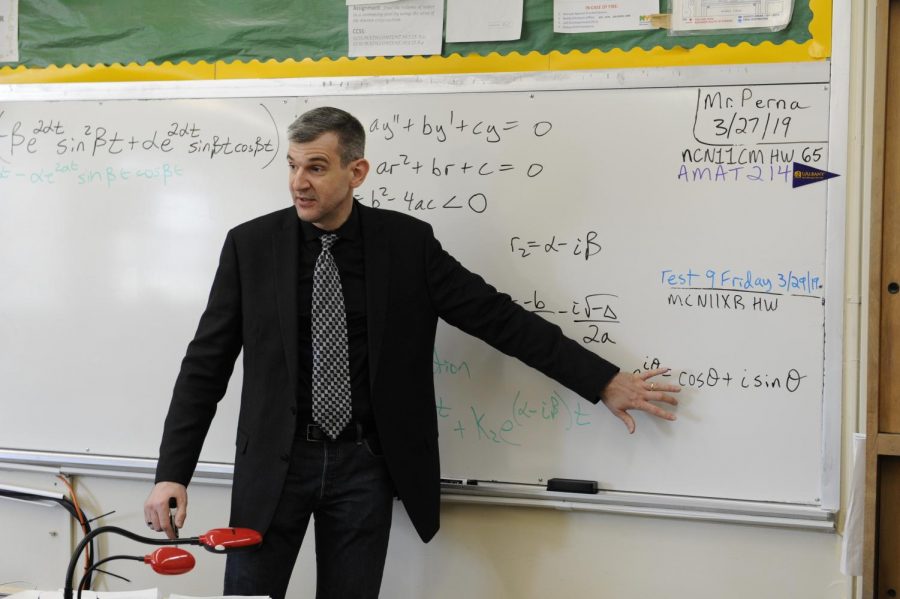Extreme Storms, Erratic Jet Streams, and the Global Warming Connection
Mr. Perna, stuck for twelve hours in traffic during the snowstorm, enthusiastically teaches his Linear & Differential Equations class.
Mathematics teacher Mr. James Perna headed home from Bronx Science on November 16th, 2018 at 4 p.m. Although he and the rest of the city were aware of the coming snowstorm, none expected the coming perilous journey to get home.
Mr. Perna and many others were stuck in complete gridlock. Fallen trees, accidents, and stopped, or even abandoned, cars prevented anyone on the road from moving. “It was very tiring and stressful to endure that situation. I spent the night on Gun Hill Road, not far from major highways, and I continually heard the desperate screams of parents with children and other loved ones. I observed elderly ones limping to train stations, and firetrucks and ambulances trying to respond to emergencies.” Despite the traumatizing and tiring ordeal, Mr. Perna persevered. He was able to make it home at 4 a.m. the next morning, and went as far as coming to school the next day. “My wife called me throughout the ordeal to encourage me. I was very close to calling in absent for the next day, but I decided that I wanted to come in, so that I could feel that in some way I could stand up to this terrible ordeal and not let it defeat my plans to be in the classroom.” While some decided to trek their way to the subways, others waited for the 6 p.m. Vallo buses, which did not arrive at Bronx Science to take students home until 11 p.m., causing many dedicated teachers to stay at Bronx Science until this time to safely supervise the students stranded at school.
So why was New York City so unprepared for this storm? Meteorologists had evidence that the storm was coming, but also saw how unlikely it was. Weather models seemed to show no signs of a massive storm, and odds were against the snowstorm from happening. Jeff Berardelli, a meteorologist, wrote in his article for CBS, “Even if [the snow] were to accumulate, forecasters rationalize, surely the warm urban streets and highways will melt the snow on contact. So maybe there will be a few inches on the grass, but the streets won’t be worse than a little slushy.” Additionally, data showed that the snowstorm would break a 150 year November record.
I spent the night on Gun Hill Road, not far from major highways, and I continually heard the desperate screams of parents with children and other loved ones. I observed elderly ones limping to train stations, and firetrucks and ambulances trying to respond to emergencies,” said Mr. Perna, Mathematics teacher.
Some theories suggest that global warming is causing a more erratic jet stream, leading to more extreme storms. However, Mr. Edward Wren, an A.P. Environmental Science teacher, doesn’t believe that there is enough evidence to say that the storm in November was due to global warming. “Too little is known about this type of storm in November to tell if it is related to climate change. Although it is the worst November snow storm that New York City has seen in over one hundred years, scientists don’t seem to know if it is due to climate change at this point,” Wren said. He added that New York City isn’t quite prepared for future storms with its current outdated systems. “Apparently everything is old and in need of repair, but it is very expensive and takes a long time. My understanding is that it is a huge system that is not designed to be flexible in emergency situations. There is no give if one area gets more use than another,” Wren said.
Some programs were installed in New York City to prevent hazards due to climate change, such as the Climate Change Adaptation Task Force (CCATF) and the Climate Resiliency Design Guidelines; additionally, New York City’s Emergency Management Department’s plan for “Winter Weather” primarily promotes creating engineering guidelines, building maintenance, and alerting and educating the public about preparedness. In this example, however, alerting was not an option, while guidelines and maintenance would take a significant amount of time to implement and enforce.
As a whole, the storm may correlate with evidence of global warming, but it would be an assumption to say that the storm was directly caused by it. However, it is still clear that the city should focus on creating better infrastructure so that it can be better prepared for unexpected events in the future.
Lauren Handler is a Graphic Designer for ‘The Science Survey’ and a Academics Section Reporter for the Bronx Science yearbook, ‘The Observatory.’...
Miles Conn is the Chief Photo Editor and and a Photographer for both the ‘The Science Survey’ and ‘The Observatory.’ Miles has always had an interest...











